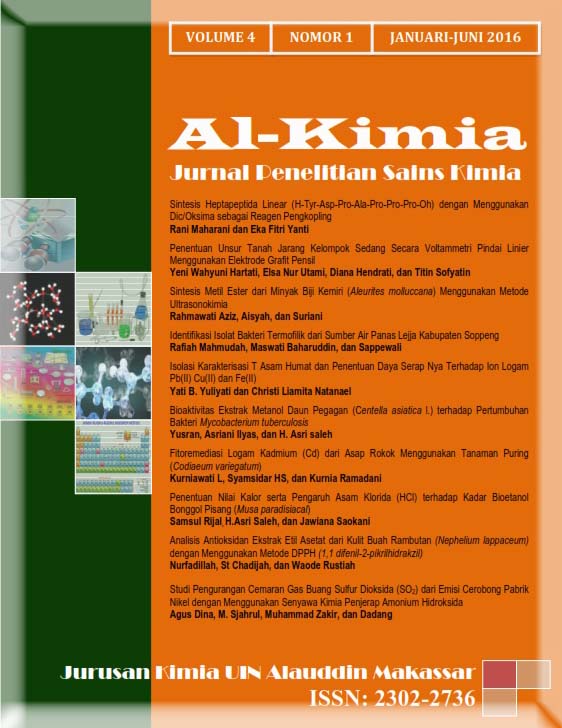Identifikasi Isolat Bakteri Termofilik dari Sumber Air Panas Lejja, Kabupaten Soppeng
Abstract
Identification of bacterial isolates local termofilik at hot springs is the first step of a series of studies of the exploration and utilization of indigenous bacteria an area. This research aims to know the bacterial isolate bacteria from the genus termofilik in the hot springs at Soppeng Lejja and know the optimum incubation time and temperature on the growth of bacterial isolates termofilik from hot springs, Soppeng Regency Lejja. The methods used in the study include the creation of media, rejuvenation, the identification of isolates of bacteria. Bacterial identification to genus level based on Bergey's Manual of Determinative Bacteriology are done with different test, namely: gram staining test, oxidation test, fermentation test, carbohydrates test, SIM test, TSIA test, Mr/Vp test, citrat test and urea test. The results showed that bacterial isolates identified as termofilik in the genus Pseudomonas sp, which is a gram-negative, rod-shaped cells against oxidation test, positive, negative and red metyl test against a test fermentation. indol, motility, citrate, urea and the production of H2S.Downloads
References
Ayu, Dyah Saropah, et.all. “Kinetika Reaksi Enzimatis Ekstrak Kasar Enzim Selulase Bakteri Selulolitik Hasil Isolasi dari Bekatul”. Alchemy vol 2, no. 1 (2012).
Buditianingsih, Karina, et.all. “Isolasi Bakteri Termofilik Dari Sumber Air Panas Di Songgoriti”. Prosiding Tugas Akhir Semester Genap. (2011).
Christina, Dessy Sianturi. “Isolasi Bakteri dan Uji Aktivitas Amilase Termofil Kasar Dari Sumber Air Panas Penen Sibirubiru Sumatera Utara”. Tesis (Medan: Sekolah Pascasarjana Universitas Sumatera Utara).
Departemen Agama Republik Indonesia. Al-Qur’an dan Terjemahnya. Jakarta: Depag, 2002.
Fikrinda. “Isolasi dan Karakterisasi Bakteri Penghasil Selulase Ekstremofilik dari Ekosistem Air Hitam”. Tesis.Bogor: IPB. 2000.
Ginting, Jusuf. “Isolasi Bakteri dan Uji Aktivitas Enzim Amilase Kasar Termofilik dari Sumber Air Panas Semangat Gunung Kabupaten Karo Sumatera Utara”. Tesis.Medan: USU. 2009.
Hartanti. “Isolasi dan Seleksi Bakteri Selulolitik Termofilik dari Kawah Air Panas Gunung Pancar, Bogor”.
Haryani, Y.,et,all. “Fermentasi Karbohidrat Oleh Isolat Salmonella spp. dari Jajanan Pinggir Jalan”. Jurnal Indo Chemistry Acta 3, no. 1 (November, 2012): h.
Irianto, Koes. Mikrobiologi: Menguak Dunia Mikroorganisme. Bandung: Yrama Widya, 2006.Hafsah. “Pengaruh Suhu Dan Ph Terhadap Aktivitas Protease Bakteri Termofilikdari Sumber Air Panas Lejja Kabupaten Soppeng Sulawesi Selatan Sebagai Sumber Belajar Mikrobiologi”. Tesis. Malang: Universitas Negeri Malang. 2007.
Kismiyati, et.all. “Isolation And Identification Gram Negative Bacteria At Lessions Of Gold Fish (Carassius auratus) By Infestation Ectoparasite Argulus sp”. Jurnal Ilmiah Perikanan dan Kelautan vol. 1 no. 2 (November, 2009).
Locke, Thomas. et,all. Mikcrobiology and Infectioous Diseases on the move, terj. Rizqi Akbarani. Jakarta: Indeks, 2013.
M, H. Subandi. Mikrobiologi: Perkembangan, Kajian dan Pengamatan dalam Perspektif Islam. Bandung: Remaja Rosdakarya, 2010.
Maranatha, Betsy. “Aktivitas Enzim Selulase Isolat Asal Indonesia pada Berbagai Substrat Limbah Pertanian”. Skripsi. Bogor: Fak. Matematika dan Ilmu Pengetahuan Alam IPB, 2008.
Maria dan Surya. “Isolasi dan Identifikasi Bakteri Termofilik dari
Sumber Mata Air Panas Songgoriti Setelah Dua Hari Inkubasi”. Jurnal Teknik Pomits. vol. 1 no. 1 (2012).
Marina, Iche Dewi. “Isolasi Bakteri dan Uji Aktivitas Kitinase Termofilik Kasar dari Sumber Air Panas Tinggi Raja, Sumalungun Sumatera Utara”. Tesis. Medan: USU, 2008.
Muharni, et,all. “Isolasi dan Identifikasi Bakteri Penghasil Kitinase dari Sumber Air Panas Danau Ranau Sumatera Selatan”. Laporan Hasil Penelitian. Lampung: Fak. MIPA Universitas Lampung, 2010.
Mushoffa. “Isolasi dan Identifikasi Bakteri Selulolitik dari Feses Kambing”. Skripsi (Malang: Fak. Sains dan Teknologi UIN Maulana Malik Ibrahim, 2012).
Pakpahan, Rosliana. “Isolasi Bakteri dan Uji Aktivitas Protoase Termofilik dari Sumber Air Panas Sipohon Tapanuli Utara Sumatera Utara”, Tesis, (Medan : USU 2009), h. 5.
Risdianto, Didik dan Soetoyo. “Survei Terpadu Geologi, Geokimia Dan Geofisika Daerah Panas Bumi Massepe, Kabupaten Sidenreng Rappang Sulawesi Selatan”. Laporan Hasil Penelitian (Makassar: Pusat Sumber Daya Geologi, 2008), h. 3.
Safrilya, Evrin Vanadianingrum. “Isolasi dan Karakterisasi Bakteri Penghasil Enzim Xilanase dari Cairan Rumen Kambing, Domba dan Sumber Air Panas di Cipanas”. Skripsi (Bogor: Fak. Peternakan IPB, 2008), h. 7.
Sari, Ratna Hadi, et.all. Dasar-Dasar Mikrobiologi. Jakarta: UI-Press, 2007
Suriawiria, Unus. Mikrobiologi Air. Bandung: P.T. ALUMNI, 2008.Wesley A. Volk dan Margaret F. Wheeler. Mikrobiologi Dasar (Basic Mikrobiology), terj. Markham. Jakarta: Erlangga, 1993.
Suyati. “Identifikasi Dan Uji Antibiotik Bakteri Gram-Negatif Pada Sampel Urin Penderita Infeksi Saluran Kemih (Isk)”. Skripsi (Manokwari: Fak. MIPA, 2010), h. 17-20.
W. Bibiana, Lay. Analisis Mikroba. Jakarta: PT RajaGrafindo Persada. 1994.
“Karakterisasi dan Identifikasi Bakteri Termofilik Amilolitik dengan Menggunakan Metode Fenotifik dan Metode Molekuler Gen Parsial 16S rRNa”, Skripsi (Bandung: UPI, 2010), h. 2.
Copyright (c) 2018 Al-Kimia

This work is licensed under a Creative Commons Attribution-NonCommercial-ShareAlike 4.0 International License.
Authors who publish with this journal agree to the following terms:
1) Authors retain copyright and grant the journal right of first publication with the work simultaneously licensed under a Creative Commons Attribution License that allows others to share the work with an acknowledgement of the work's authorship and initial publication in this journal.
2) Authors are able to enter into separate, additional contractual arrangements for the non-exclusive distribution of the journal's published version of the work (e.g., post it to an institutional repository or publish it in a book), with an acknowledgement of its initial publication in this journal.
3)Authors are permitted and encouraged to post their work online (e.g., in institutional repositories or on their website) prior to and during the submission process, as it can lead to productive exchanges, as well as earlier and greater citation of published work (See The Effect of Open Access).


